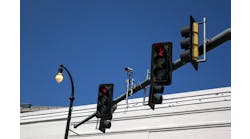Active traffic management (ATM) strategies have been deployed in cities all over the world to deal with roadway congestion and safety concerns.
The common goal of all of these strategies is to improve the efficiency and safety of the transportation network by influencing driving behavior. Traffic engineers do not have direct control of their subjects, especially on freeways. Their only tool is the delivery of the right information at the right place and time.
Minnesota’s Smart Lanes is the brand name of the ATM system implemented on I-35W and I-94, the two busiest freeways in the Twin Cities of Minneapolis and St Paul. The centerpiece of this system, and a novel idea at the time of its installation since no other U.S. city has anything similar, is the implementation of Intelligent Lane Control Signs (ILCS). Similar systems in Europe have been proven effective at reducing collisions and improving traffic flow. The ILCS consists of one full-matrix electronic sign over each lane of traffic, spaced approximately every half-mile. The ILCS can provide lane-specific real-time information to help motorists make informed decisions. The signs are illuminated during traffic incidents to indicate closed lanes, lanes blocked due to a crash or obstruction and adjacent lanes impacted by such events, as well as providing a means to guide drivers to the most appropriate alternative lane or lanes.
The initial concept of the ILCS was conceived as part of a multifaceted effort to relieve one of the largest bottlenecks in the network located at the last 1.5 miles of northbound I-35W south of downtown Minneapolis. The location of the road made the addition of new lanes cost-prohibitive, leading to the use of the shoulder as the only viable alternative driving lane. The use of a shoulder as a driving lane on a heavily traveled route can lead to an incident management disaster; a minor stall would completely block a lane, resulting in congestion and the delay of first responders. The compromise was the use of the ILCS to direct traffic away from the affected lane as upstream as needed to allow emergency vehicles to reach the incident and clear it as fast as possible.
An active ILCS advises commuters of a lane closure well in advance of the closure point.
Ignoring the signs
The general utility of the ILCS was recognized, leading to an installation over an 18-mile section of I-35W south of Minneapolis in 2010 and a similar deployment on the 8-mile segment of I-94 that connects the downtown sections of Minneapolis and St. Paul. In addition to the incident management role, the ILCS also allows the deployment of an advisory variable speed limit (VSL) system aimed at enhancing safety and improving the flow of traffic by slowing down traffic before meeting the tail of congestion queues.
Both ATM concepts depend on the voluntary compliance of drivers to the directions displayed in the signs (which must be readily understandable). Although a human-factors experiment utilizing a driving simulator helped select the most well-understood signs and messages, such studies cannot capture the collective effect of hundreds of drivers making decisions based on the provided information. To conclude the evaluation, the Minnesota Department of Transportation (MnDOT) turned to the Minnesota Traffic Observatory at the University of Minnesota to assess performance-based on long-term observations of ATM system operations.
The first two studies determined the effectiveness of the VSL system of the ATM. The results of these studies were presented in a supplement to this publication (Winter 2015 edition of Transportation Management & Engineering [TM&E]) and illustrated the limited influence of the VSL system, indicating that drivers generally ignored the advisory limits.
These findings, combined with discovered deficiencies in the required sensor system, led to the present deactivation of the VSL system.
Incident related
This article summarizes the findings from the latest study performing an evaluation of the effectiveness of ILCS messages during incidents. The study focused on the segment of I-94 located on the westbound direction through the Minneapolis downtown area. This location was selected due to the frequency of capacity-reducing incidents occurring in this freeway segment. Such a frequent crash location was necessary because of the large number of possible strategies one can employ using this type of system.
The goal was to analyze the impacts of the ILCS incident-management component on driving behavior during non-recurrent congestion events. This was accomplished through high-resolution video data collected along westbound I-94 using Minnesota Traffic Observatory (MTO) and Regional Traffic Management Center (RTMC) surveillance cameras. To target incidents, the ILCS actuation log obtained from the RTMC identified individual events categorized by time and gantry location. The events were thoroughly analyzed using loop detector data and lane change counts, which were collected manually. Lane change counts were amassed manually by using video overlays that indicated lane number and distance. In 2012 and 2013, an event visualization that met research requirements was created and was accomplished by displaying the ILCS messages graphically with respect to the gantry. Time-stamped configuration changes were shown on graphs to illustrate the gantry displayed above each lane. First-responder time, incident time, weather conditions and the status of an upstream dynamic message sign (DMS) provided further information about the event.
Although this research could have taken a more traditional approach in testing and measuring the effect such a system has on overall congestion, such a quantification would have been rough at best, given the stochastic nature of both incident conditions and response scenarios. Instead, this research aimed at quantifying the system’s effects on drivers, specifically on inducing and directing a desirable lane-selection behavior. Thus the strength of various uses of the ATM in managing traffic during incidents was explored, rather than a general level of success in improving traffic. To achieve this goal, the centerpiece of this research was the comparison and modeling of lane-change rates under different strategies. This was a difficult and daunting task in which a large group of undergraduate students committed hundreds of hours detecting, collecting and geolocating all lane changes in the target freeway section.
The research followed two main thrusts. The first was a detailed analysis of 28 incident events selected from approximately 481 recorded events between 2012 and 2013. (Given the detailed nature of the analysis, the reduction to 28 events was possible within the given project budget.) The second thrust was a statistical analysis testing a number of hypotheses prompted by questions proposed by MnDOT. Where the empirical analysis of each of the selected events offered a detailed deconstruction of the effect of each particular scenario on traffic and driver lane-selection behavior, the statistical analysis quantified and ranked the different incident-management alternatives.
ILCS can be employed to re-route traffic in advance of an incident or work zone.
Some positives
From both analyses, it can be concluded that the use of ILCS for incident management has a significant effect on driver behavior, specifically in prompting proper lane selection under capacity-reducing incidents. Although the ILCS was envisioned as a unified system of approximately equidistant, successive gantries, based on the observations made in this research, the inclusion of more than two gantries upstream of the incident in a response strategy is unnecessary, since it does not seem to offer additional benefits.
Another general observation illustrating evidence against the equidistant placement of ILCS is that the signs are greatly affected by the particular road geometry and the sign location in respect to major entrance and exit ramps. It could be considerably more effective and perhaps more economical to determine locations of the ILCS based on historical crash locations rather than utilized as a blanket system on a freeway corridor.
In terms of specific scenarios of ILCS usage, this study showed that specific sign configurations induce more lane changes than others, specifically the USE CAUTION sign (yellow arrow) which has a relatively weak effect on lane changes, especially in comparison to stronger messages such as MERGE (animated chevrons), LANE CLOSED AHEAD (LCA) and LANE CLOSED (red “X”). Perhaps intuitively, the merge chevron sign seems to be the strongest sign for inducing lane changes upstream of an incident. The research also has shown that the combination of LCA followed by a merge chevron on successive gantries is the most effective. During this research, it was not possible to observe or compare the strength of an ILCS merge chevron against a Freeway Incident Response Safety Team (FIRST) truck-mounted arrow board, and by extension the effectiveness of a combination of a single ILCS and a FIRST unit.
The analysis as well as the empirical evidence show that the visual presence of first responders such as FIRST and state patrol vehicles has an observable positive effect on lane-change behavior, but not as effective as instructions on an ILCS. This makes sense since although the presence of first responders is a direct confirmation of the problem, it does not provide information to the drivers on which lane to choose. Therefore, the impact of the first responder is strong, but not as strong as an effective ILCS message suggesting that the presence of a first responder does not effectively replace the ILCS system.
Although not securely defined due to limited relevant events, the presence of a crash-related DMS message upstream of the ILCS and the incident location has minimal but observable additional effect on lane-change rates. Unfortunately, the incident events observed did not allow observation of the DMS without the ILCS being active, so it was not possible to compare. From the current findings, the DMS contributes positively to the incident management effort, albeit not enough to justify a DMS-ILCS pairing as a cost-effective strategy. Actually, as already mentioned, the presence of a first responder has a positive impact on lane changes and is much more significant than the DMS.
Finally, from all the events observed, a qualitative observation of ILCS operation in view of heavy congestion can be made. Specifically, the ILCS is becoming ineffective under stop-and-go conditions. It was observed that in most cases the ILCS was capable of emptying the incident lane well upstream of the obstruction caused by the incident, even when the next lane was considerably congested. As noted on prior research on the merits of a work-zone zipper merge, in such situations, wasting storage by emptying a lane early may not be the most efficient strategy. Overall, utilizing the ILCS to induce lane changes out of the incident lane can not only become ineffective, but also may be detrimental if the freeway section is under stop-and-go conditions. After a certain point, the preferred operational strategy may be to switch off the ILCS messages or display an innocuous message rather than instruct drivers to change lanes. The latter is even more relevant if a first responder protecting the incident scene is already present.
Given the plethora of options and combinations of incident-management strategies possible with an ILCS system, even more if combined with first responders and other information sources, the limited resources available for this project did not allow an exhaustive evaluation and ranking. Regardless, good planning, prioritization and close collaboration with MnDOT engineers allowed for some strong and revealing results that answer pertinent questions. The work did not venture on a cost-benefit comparison between ILCS and DMS given the large differences in initial and maintenance costs. Such questions are certainly easier to answer following this research.



